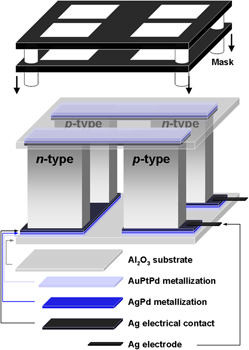Crossref Citations
This article has been cited by the following publications. This list is generated based on data provided by
Crossref.
Weidenkaff, Anke
Trottmann, Matthias
Tomeš, Petr
Suter, Clemens
Steinfeld, Aldo
and
Veziridis, Angelika
2013.
Thermoelectric Nanomaterials.
Vol. 182,
Issue. ,
p.
365.
Funahashi, Ryoji
Matsumura, Yoko
Takeuchi, Tomonari
Tanaka, Hideaki
Norimatsu, Wataru
Combe, Emmanuel
Suzuki, Ryosuke O.
Wan, Chunlei
Wang, Yifeng
Kusunoki, Michiko
and
Koumoto, Kunihito
2013.
New n-type Silicide Thermoelectric Material with High Oxidation Resistance.
MRS Proceedings,
Vol. 1490,
Issue. ,
p.
103.
Muto, Andrew
Yang, Jian
Poudel, Bed
Ren, Zhifeng
and
Chen, Gang
2013.
Skutterudite Unicouple Characterization for Energy Harvesting Applications.
Advanced Energy Materials,
Vol. 3,
Issue. 2,
p.
245.
Thiel, Philipp
Eilertsen, James
Populoh, Sascha
Saucke, Gesine
Döbeli, Max
Shkabko, Andrey
Sagarna, Leyre
Karvonen, Lassi
and
Weidenkaff, Anke
2013.
Influence of tungsten substitution and oxygen deficiency on the thermoelectric properties of CaMnO3−δ.
Journal of Applied Physics,
Vol. 114,
Issue. 24,
Schrade, M.
Kabir, R.
Li, S.
Norby, T.
and
Finstad, T. G.
2014.
High temperature transport properties of thermoelectric CaMnO3−δ — Indication of strongly interacting small polarons.
Journal of Applied Physics,
Vol. 115,
Issue. 10,
Schilm, Jochen
Pönicke, Andreas
Kluge, Martin
Sichert, Ina
Martin, Hans-Peter
and
Michaelis, Alexander
2015.
TiOx Based Thermoelectric Modules – Manufacturing, Properties and Operational Behavior.
Materials Today: Proceedings,
Vol. 2,
Issue. 2,
p.
770.
Saucke, Gesine
Populoh, Sascha
Thiel, Philipp
Xie, Wenjie
Funahashi, Ryoji
and
Weidenkaff, Anke
2015.
Compatibility approach for the improvement of oxide thermoelectric converters for industrial heat recovery applications.
Journal of Applied Physics,
Vol. 118,
Issue. 3,
Caballero-Calero, Olga
and
D'Agosta, Roberto
2017.
Review—Towards the Next Generation of Thermoelectric Materials: Tailoring Electronic and Phononic Properties of Nanomaterials.
ECS Journal of Solid State Science and Technology,
Vol. 6,
Issue. 3,
p.
N3065.
Kaur, Kulwinder
Rai, D. P.
Thapa, R. K.
and
Srivastava, Sunita
2017.
Structural, electronic, mechanical, and thermoelectric properties of a novel half Heusler compound HfPtPb.
Journal of Applied Physics,
Vol. 122,
Issue. 4,
Weidenkaff, Anke
Cahen, D.
Cifarelli, L.
Ginley, D.
Slaoui, A.
Terrasi, A.
and
Wagner, F.
2017.
Thermoelectricity for future sustainable energy technologies.
EPJ Web of Conferences,
Vol. 148,
Issue. ,
p.
00010.
Shen, Zu-Guo
Wu, Shuang-Ying
Xiao, Lan
and
Chen, Zu-Xiang
2017.
Proposal and assessment of a solar thermoelectric generation system characterized by Fresnel lens, cavity receiver and heat pipe.
Energy,
Vol. 141,
Issue. ,
p.
215.
He, Ran
Schierning, Gabi
and
Nielsch, Kornelius
2018.
Thermoelectric Devices: A Review of Devices, Architectures, and Contact Optimization.
Advanced Materials Technologies,
Vol. 3,
Issue. 4,
Joshi, H
Rai, D P
Laref, Amel
and
Thapa, R K
2019.
Electronic, and thermoelectric properties of half-heusler compounds MCoSb (M = Ti, Zr, Hf): a first principles study.
Materials Research Express,
Vol. 6,
Issue. 6,
p.
066307.
Kim, Changwook
and
Kim, Kyoungsik
2021.
Enhancement of solar thermoelectric power generation by optical and thermal management with highly transparent aerogel window.
Solar Energy Materials and Solar Cells,
Vol. 230,
Issue. ,
p.
111224.
Wang, Qian
Pornrungroj, Chanon
Linley, Stuart
and
Reisner, Erwin
2021.
Strategies to improve light utilization in solar fuel synthesis.
Nature Energy,
Vol. 7,
Issue. 1,
p.
13.
Popoola, A I
Odusote, Y A
Ogunjo, S T
and
Distasio, R A
2023.
Exploring the suitability of narrow-bandgap compounds for thermoelectric application.
Physica Scripta,
Vol. 98,
Issue. 7,
p.
075501.
Merkulov, O.V.
Shamsutov, I.V.
Ryzhkov, M.A.
Politov, B.V.
Baklanova, I.V.
Chulkov, E.V.
and
Zhukov, V.P.
2023.
Impact of oxygen vacancies on thermal and electronic transport of donor-doped CaMnO3-.
Journal of Solid State Chemistry,
Vol. 326,
Issue. ,
p.
124231.
Ahmad, Aquil
and
Liu, Chia-Jyi
2023.
Investigation of the electronic structure, mechanical, and thermoelectric properties of novel semiconductor compounds: XYTe (X = Ti/Sc; Y = Fe/Co).
Physical Chemistry Chemical Physics,
Vol. 25,
Issue. 24,
p.
16587.
Pratama, Fachrizal Rian
and
Saraswati, Vierta
2024.
Instrument model for thermoelectric seebeck effect using TEC-12706 and TEG-SP1848 module.
Vol. 3103,
Issue. ,
p.
030002.
Tindibale, Edward
Mulwa, Winfred M.
and
Adetunji, Bamidele I.
2024.
Elastic anisotropy, mechanical, lattice dynamics, and electronic properties of MPdZ (M = Hf, Zr, Ti; Z = Sn, Ge, Si). DFT study.
Computational Condensed Matter,
Vol. 39,
Issue. ,
p.
e00904.



